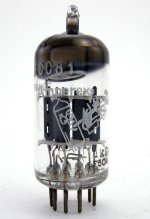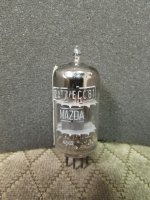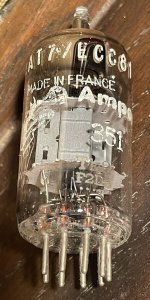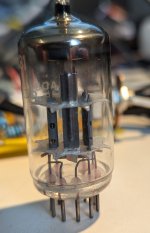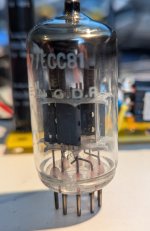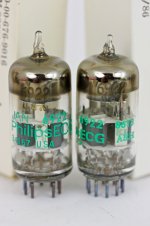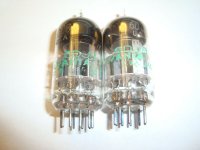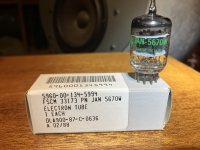Think you Haltron is a rebranded RFT. Not sure hundred percent, have to take a look in my boxes.
The RFT ECC81s I've seen have not the structure of the Haltron, but do check your stash.
Get a closeup picture of the codes circled in the picture. They are likely the Philips/Mullard type and factory markings. See pic.
Well, that's the problem - there are no codes on the Hoges ECC88.
With an image search I found some examples of tubes with four glass seams. They seem to be French, either Radiotechnique which was owned by Philips, or Mazda/Belvu.
Attachments
Last edited:
It's a bit difficult to see all details in the photos, but they do look similar to the Haltron, especially the Amperex and the RT: the ribbed plates and and the placement/shape of the holes in the plates.
Google Made in France 12AT7, there are lots of other photos.
(Not relevant to you but I found this rather nice webpage dissecting 12AT7s http://www.analogdial.com/12AT7/12AT7.html)
(Not relevant to you but I found this rather nice webpage dissecting 12AT7s http://www.analogdial.com/12AT7/12AT7.html)
Attachments
These look a lot like your ECC88, which points towards USA origin.
Attachments
Last edited:
Indeed they do - a great find! Sylvania was bought by Philips in 1981 and tube manufacturing continued at the Emporium plant in Pennsylvania (note -"sylvania"!) until the late '80s. The Philips tube in the photo above has smooth plates like the Hoges (the Sylvanias are ribbed), so it seems to have been manufactured under the Philips regime. Strangely enough, I had a pair of the ECG Philips ECC88 in my Musical Fidelity X-Can V3 headphone amp decades ago, the amp still plays beautifully but with upgraded tubes.
I think we safely can say that the Hoges ECC88 was manufactured by ECG Philips in USA. Thanks for the excellent detective work, MerlinB!
https://www.effectrode.com/knowledge-base/thats-a-sylvania-tube-the-print-is-green-no-its-blue/

I think we safely can say that the Hoges ECC88 was manufactured by ECG Philips in USA. Thanks for the excellent detective work, MerlinB!
https://www.effectrode.com/knowledge-base/thats-a-sylvania-tube-the-print-is-green-no-its-blue/
Did some more thinking and surfing and probably have to revise my suggestion that the Haltron was manufactured by Philips in the'80s. There are a lot of photos on the web of Sylvania ECC82 made in the '70s. Here are two examples:

Dated June 1977 and March 1974, respectively. From what I see, they are identical to the Hogen, which probably was made/delivered 11 January 1972.
So there goes. Now back to the Haltron ECC81!
Dated June 1977 and March 1974, respectively. From what I see, they are identical to the Hogen, which probably was made/delivered 11 January 1972.
So there goes. Now back to the Haltron ECC81!
Sorry, mixed the manufacturers up in the previous post (#31). I wrote "Haltron" in the first sentence, should be "Hoges" of course.
A possibility that the ECC81/12AT7 is a Matusushita?
I've a couple here and they both have the 4 seams on top.
I've a couple here and they both have the 4 seams on top.
I don't think so, the ECC81 Matsushitas I've seen photos of have an angled getter, 45 degrees, which also shows in the silver deposit.
So far, the tube closest to the Haltron ECC81 is Indian BEL. However, the Haltron has a few peculiarities. First, the ribbed anode only has two ribs (three is more common):

Also, of the three round holes on the side of the anode only the central one is fully visible, as for the upper and lower ones you only see half of them:


So everyone reading this - keep looking!
So far, the tube closest to the Haltron ECC81 is Indian BEL. However, the Haltron has a few peculiarities. First, the ribbed anode only has two ribs (three is more common):
Also, of the three round holes on the side of the anode only the central one is fully visible, as for the upper and lower ones you only see half of them:
So everyone reading this - keep looking!
Nearly as good as the 5670 base, the 9LS base for the 6EU7 and the 9MJ base for the 20EZ7 (electronically 12AX7s - just different pin-outs)To be fair, the tubes we mostly use like the ECC88 have an anode on pin-6, right next to the heater on pin-5, which is not exactly ideal for hum! If only they could all be like the 5670.
Nearly as good as the 5670 base, the 9LS base for the 6EU7 and the 9MJ base for the 20EZ7 (electronically 12AX7s - just different pin-outs)


Glad that the 5670 pinout is getting good recognition and agree that this 9LS pinout has some serious merit.
The 5670 I have are engraved into the glass with the number 5670. They are also marked in green print "GE JAN 5670W"
So as I understand it JAN is Joint Army and Navy and the W is an extra ruggedised version.
In the spirit of the OP's quest - searching for the manufacturer of ECC81, ECC88 etc - I have speculated as to whether the GE JAN 5670W tubes I have were really manufactured by GE in the USA or whether they are clones produced much more recently elsewhere possibly China?
JAN-5670W green ink says made in USA, 5670 etched into glass. Box says it was packed put into inventory in February 1988
I find the 5670 to be a good valve. Same gain as 6DJ8, lower transconductance, higher rp but abnle to operate at higher anode voltages. Not as linear as (say) the 7044 or 6CG7 but more gain (35 versus 20) so almost the same low THD for Vout up to 20VRMS,
6EU7 has a good pin-out and is a good 12AX7. TYhe base and pin-out were designed speficially for phono and microphone amps. Marshall amps used them too (don't know why ...).
The 20EZ7 is a 6EU7 with a different heater, used in RCA's 100mA series-string designs that used 117VAC straight from the wall socket WITH NO INTERVENING POWER TRANSFORMER. LOW COST DESIGNS THAT LED TO FIRES AND DEATHS. Actually the 20EZ7 is a good valve that can run with a 10V heater supply or 20V heater supply.
I find the 5670 to be a good valve. Same gain as 6DJ8, lower transconductance, higher rp but abnle to operate at higher anode voltages. Not as linear as (say) the 7044 or 6CG7 but more gain (35 versus 20) so almost the same low THD for Vout up to 20VRMS,
6EU7 has a good pin-out and is a good 12AX7. TYhe base and pin-out were designed speficially for phono and microphone amps. Marshall amps used them too (don't know why ...).
The 20EZ7 is a 6EU7 with a different heater, used in RCA's 100mA series-string designs that used 117VAC straight from the wall socket WITH NO INTERVENING POWER TRANSFORMER. LOW COST DESIGNS THAT LED TO FIRES AND DEATHS. Actually the 20EZ7 is a good valve that can run with a 10V heater supply or 20V heater supply.
Attachments
-JAN-5670W green ink says made in USA, 5670 etched into glass. Box says it was packed put into inventory in February 1988
OK that makes sense thanks for explaining and posting the photo, some photos from the ones I have showing the markings:
The engraving of "5670" is clearly visible (on the right of photo) and I have marked the engraving in red for clarity. There is also some sort of dot code, it looks like 5-bit Baudot paper tape code, if so it spells "MQS"
The Getter is both a ring and a disk.
The GE logo is very clearly marked.
81-30 if this means week 30 in 1981 then week 30 is from July 20th to July 26th. The other marking 81-08 may refer to August 1981. Looking at other tubes there are various date stamps from 1981 to 1988.
Inside the tube looks very solidly constructed, that said it has a "roughness" to it that you would not see (for example) in a tube produced by the Japanese Hamamatsu company.
Here are the JAN 5670W tubes I have, they all work:
As regards the maximum Plate voltage some datasheets/manufacturers quote 300 Volts, some quote 330 Volts.
The engraving of "5670" is a massive plus point!
The number of commercial type tubes I have seen in years gone by, that had little or no paint left on them (and therefore hard to identify) is a large number.
As far as I can find out these tubes were made by many companies: GE, Raytheon, Bendix, the 2C51 version by Western Electric, Tung-Sol and others.
-
Last edited:
- Home
- Amplifiers
- Tubes / Valves
- Two mystery tubes: Hoges ECC88 and Haltron 12AT7
